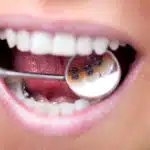Are you unsure whether fixed or loose braces are the right choice for you? Here we show you the advantages, disadvantages and costs.
Braces are a popular method of correcting misaligned teeth and bite problems.
They are used by dentists and orthodontists to improve the bite and promote long-term dental health.
There are different types of braces, each with their own advantages and disadvantages.
In this article, we will take a closer look at the different types of braces and also discuss their care and cost.
| Get 150 € discount on your dental correction! |

Book a consultation appointment now at a nearby DrSmile partner practice and find out if teeth straightening with aligners is right for you.
The appointment is completely non-binding and does not involve any costs.
With the code “THATSMILE150” you will receive 150 € discount on the treatment.
What exactly is a brace?
Braces are orthodontic appliances used to correct misaligned teeth and improve bite alignment.
They traditionally consist of brackets, bands and wires that are applied to the teeth and apply gentle pressure to move the teeth into the correct position.
In the meantime, however, there are also more modern variants of braces, for example, removable models, ceramic braces or invisible dental splints.
Braces can be used on children, adolescents and adults.
Why are braces used?
Braces are versatile and serve more than one purpose. Among others:
1. correction of malocclusions
One of the main reasons for using braces is to correct misaligned teeth.
Misaligned teeth, such as crooked teeth, gaps between teeth, or overbites, can affect the appearance of the dentition and cause long-term dental health problems.
2. improvement of the bite position
Braces can also help improve bite alignment.
Poor bite alignment can lead to problems such as TMJ disorders, jaw cracking and tooth wear.
The use of braces can correct or prevent these problems.
3. prevention of dental and jaw problems.
The use of braces can also serve to prevent future dental and jaw problems.
Correcting misaligned teeth and bite problems can prevent long-term damage that can lead to tooth loss, gum disease and other oral problems.

What are the different types of braces?
There are different types of braces that can be selected depending on the individual case and patient preference.
The two main categories are fixed braces and removable braces.
1. fixed braces
Fixed braces are the traditional type of braces that consist of metal brackets and wires.
However, there are also modern options such as ceramic braces, lingual braces and self-ligating braces.
2. metal braces
Metal braces are the most commonly used braces.
They consist of metal brackets that are bonded to the front of the teeth with special adhesives and a wire that connects the brackets together.
Metal braces are inexpensive and effective, but they are visible.
3. ceramic braces
Ceramic braces are a more aesthetic option compared to metal braces.
The brackets are made of transparent or tooth-colored ceramic, which makes them less visible.
Ceramic braces, however, are slightly more expensive and can discolor if not properly cared for.
| Get 150 € discount on your dental correction! |

Book a consultation appointment now at a nearby DrSmile partner practice and find out if teeth straightening with aligners is right for you.
The appointment is completely non-binding and does not involve any costs.
With the code “THATSMILE150” you will receive 150 € discount on the treatment.
4. lingual braces
Lingual braces are attached to the back of the teeth, making them virtually invisible.
They consist of custom-made brackets and wires that are individually fitted to the patient’s teeth.
However, lingual braces are more expensive than traditional braces and may require a longer adjustment period.
5. self-ligating braces
Self-ligating braces are a further development of conventional fixed braces.
This type of braces does not require rubber rings or wire bows, as the brackets have a mechanism that holds the wire in place.
This can shorten treatment time and require fewer follow-up visits.
6. removable braces
Removable braces are an alternative to fixed braces and can be used for certain cases of misaligned teeth.
They offer more flexibility and comfort for the patient, as they can be removed, e.g. for eating or dental care.
Removable braces are mainly used in younger patients to influence jaw growth and correct misaligned teeth.
7. aligners (invisible braces)
Aligners, also known as invisible braces, are transparent plastic trays that are custom-made to gradually move teeth into the correct position.
Aligners are removable and virtually invisible, making them a popular choice for adult patients.
They also provide more comfort when worn and require fewer follow-up visits. The retainers are also invisible and removable here.
Since providers such as DrSmile use advanced technology, the cost of the invisible braces is usually lower than that of traditional braces.
How long do braces have to be worn?
The duration of treatment with braces varies depending on the severity of the malocclusions and the individual case of the patient.
1. treatment duration for children
In children, treatment with braces can usually take longer than in adults because jaw growth is not yet complete.
The average duration of treatment is about 1-3 years, but it can be longer or shorter depending on the individual case.
2. treatment duration for adults
For adults, treatment with braces can usually be shorter than for children.
The average duration of treatment is about 6-18 months, but may vary depending on the individual case.
Braces care
Good care of braces is important to avoid complications and dental problems during treatment.
1. proper oral hygiene
It is important to brush and floss your teeth regularly to remove plaque and food debris around braces.
Good oral hygiene helps prevent tooth decay and gum problems.
2. dietary habits
Certain foods should be avoided as they can damage or discolor braces.
These include sticky sweets, hard foods, and strongly colored beverages such as coffee or tea.
3. regular control visits
Regular check-ups with the dentist or orthodontist are important to monitor the progress of treatment and make adjustments to braces when necessary.

What are the costs of braces?
The cost of braces can vary depending on the type of braces and the individual case.
As a rule, fixed braces are less expensive than removable braces.
It is advisable to inquire with the health insurance company about possible cost coverage.
Conclusion about the types of braces
Braces are effective orthodontic appliances designed to correct misaligned teeth, improve bite alignment and promote long-term dental health.
There are several types of braces, including fixed braces such as metallic, ceramic, lingual, and self-ligating braces, as well as removable braces such as traditional removable braces and aligners.
The duration of treatment varies depending on the individual case, and good care of braces is important to avoid complications.
The cost of braces can vary, and it is advisable to check with your health insurance provider about possible coverage.
| Get 150 € discount on your dental correction! |

Book a consultation appointment now at a nearby DrSmile partner practice and find out if teeth straightening with aligners is right for you.
The appointment is completely non-binding and does not involve any costs.
With the code “THATSMILE150” you will receive 150 € discount on the treatment.
FAQs about the different types of braces
At this point we will answer some frequently asked questions about the topic “types of braces”.
Does wearing braces hurt?
Wearing braces can cause mild discomfort in the beginning, but it improves over time. Pain medications can help if needed.
Can I eat normally with braces?
Yes, you can eat normally, but should avoid hard or sticky foods to prevent damage to the braces.
Can I have my teeth whitened during treatment with braces?
It is recommended to postpone teeth whitening until after the completion of treatment with braces, as the braces may interfere with the whitening agent.
How often do I need to have my braces adjusted?
Braces usually need to be adjusted every 4-6 weeks to monitor progress and make adjustments.
Can I wear braces as an adult?
Yes, adults can wear braces to correct misaligned teeth. There are special options like invisible aligners that are discreet and comfortable.



Leave a Reply